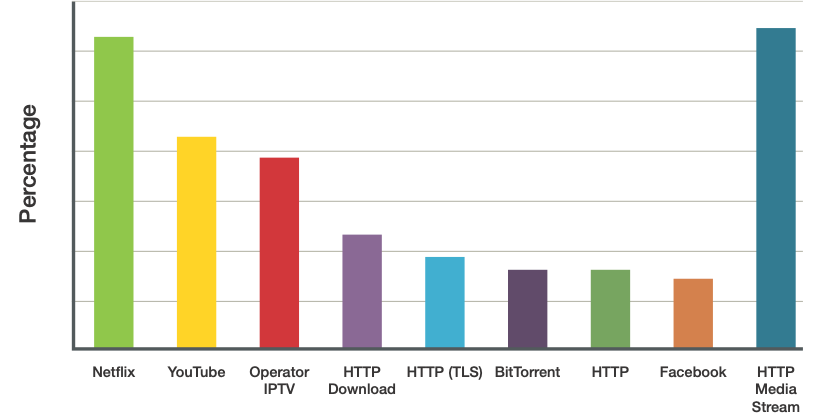For every action, there is an equal and opposite reaction – and the market success of Netflix has caused a massive pendulum swing in the market. Netflix grew popular as an aggregator of video, essentially giving users the ability to watch a wide variety of content from a single account. Amazon Prime and Hulu followed, and now every content owner is looking to monetize their content and deliver originals as part of an exclusive streaming service.
In statistics and big data, we often talk about the long tail and the short tail. Well, this year, the aggregate volume of the long tail is actually greater than the largest of the short tail providers. Last year, Netflix was the largest traffic source with almost 15% of downstream traffic.
In 2019, Netflix was edged out (slightly) by HTTP Media Stream, which represents that long tail (which was a few percentage points behind last year). You may be asking yourself "What is HTTP Media Stream?" and it would be a very valid question! HTTP Media Stream is a collection of video streaming sites that use a standard video streaming protocol that we do not track individually.

Sandvine has over 250 unique video signatures in this report, and we are barely touching the surface (something for us to expand on next year!). Our signatures include the big services that you expect: Netflix, YouTube, Twitch, Hulu, HBO Go, Instagram, Facebook, BBC iPlayer, and DirectTV Now among that list. It also includes international channels and services like Rakuten TV, Azteca TV, Daum Pot Player, Sky Go, ZDF Mediathek, Kartina TV, and even Red Bull TV.
So, what video content and providers are in the long tail? Since we are covering the global market, this is not only something like Adult Swim and AMC in the US, but NHK in Japan, Canal+ in France, and Foxtel in Australia, which historically have not registered enough volume both globally but also in their own countries. The long tail includes video ads that you see (seemingly everywhere in your browser) when you are on most websites. It also includes video sharing sites that are all over the internet.

Netflix, it is important to point out, is still significant and is the single largest source of downstream traffic on the internet. If you looked closely at the blog on brands, you saw this number already, but it still bears emphasis. As I pointed out last year, Netflix is the most efficient streaming service that we see on the internet, and we still do not see a lot of 4K being streamed (which we talk about in the report). Once that starts to pickup, we may see Netflix start to jump faster than other services, as it currently has a reasonably sized library of 4K content (especially originals).
Download the report now!
Topics: Netflix, Video Streaming, Global Internet Phenomena






